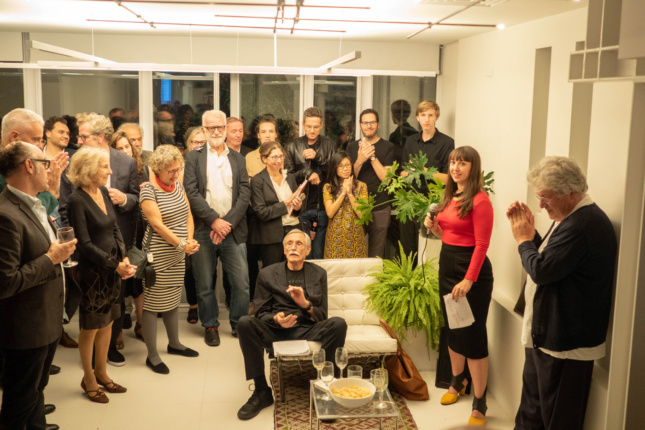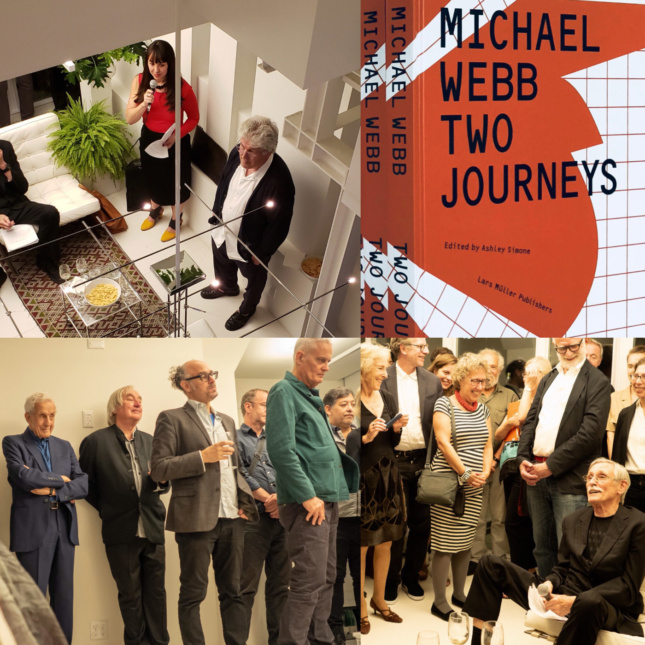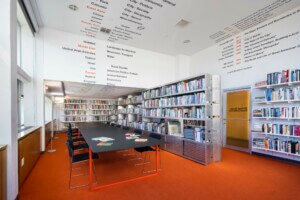Michael Webb is a virtuoso English architect, inventor, and artist who was a member of Archigram in London before emigrating to the United States in the late 1960s. Continuing his link with the group and his inventive investigations, he survives by teaching in architecture schools. Yet baldly stated, these facts hardly prepare one for the extraordinary document that is Two Journeys, his latest book.
Reading it, I have a serious suggestion: For those who have not had a chance to meet Webb or hear him speak, search online for a video of one of his lectures (there must be quite a few out there). Listen carefully, and then listen and watch it again. Then read the book carefully. His manner of speaking is slowly paced, often with the odd aside, spoken in a kind of English that those of us who remained in London after the 1960s have sullied through the influence of “Estuary English,” the result of the cosmopolitanism of London that leads one to incorporate a faintly European sentence structure, some West Indian patois, or the occasional charming Italian bon mot. Not Michael: His parlance and manner are as charming and reassuring as the surviving BBC radio program Gardeners’ Question Time, which he still probably remembers. He speaks with a trace of wistfulness, useful hints, and a whiff of friendly irony—often with quite a laugh, but behind that lies a rapierlike thrust.

That this book has finally emerged is wonderful, and for those of us who had despaired of it ever happening, it is a precious thing. Webb’s text is loaded with the same asides and nuances as the lectures themselves, accompanied by revealing pieces of characterization, such as his description of Cedric Price as, “A new suitor sporting slick-backed hair and a golden tongue”—or, “Nursing a martini whilst seated on the terrace of the Johansen house…one has the feeling that the terrace (can it really be so?) is no longer level. With the clarity of perception that a second martini brings, I realize that indeed, the plane is tipping up, at an ever-increasing angle.” Thus, in the first aside he captures the humility (or frustration) of a world where architectural ideas are the victim of style and communication, and in the second, he creates a charming lead-in to the discussion of shadow effect in the sun studies of 1988.
The journeys—and there are surely more than two—take us in and out of exquisite drawings that are never really finished. Therein lies one of the agonizing challenges to observers of the work. For surely Webb can draw (and how). Long ago I once caught a glimpse of a pre–High Wycombe project, probably from his third year, in which he wielded the shaded pencil to suggest so many of Le Corbusier’s mannerisms on a single piece of paper. Yet in an early drawing of the High Wycombe project made to illustrate the ferro-cement technique, he left it just three-quarters finished because (as I remember him saying), “It didn’t capture the material.” On other occasions, he tackled the vexed territory of oil painting with a determination that did, eventually, produce the beatific Brunhilde’s magic ring of fire, with its floating angels.
However, perfectionism has not always been accompanied by much archival concern for the state of the drawings, and tales of them being lost, damaged, blown off the roof of a car, or even forgotten are legion—and it shows in the book. In an attempt to keep the explanation of a project or train of thought going forward, the illustrations range from a fashion-plate exposure of clouds and translucent panels for his five-phase house to the succulent paintwork of Henley Regatta landscape details, along with the occasional, slightly hairy “rescued” item from an old slide collection. It would seem that the key search for perfection remains that of the idea, the pursuit of the drawing apparently being a means to the end. But in the cases of the reworked versions of the Henley project or developed versions of the house-car preoccupation, there is a search for finesse in the line, the shading, the sheer beauty of what we see. When publishing the odd item, he will negotiate hard to have the best version published—and why not?

Well, this document is there to rescue us—friends, analysts, or new converts who inevitably will pick away, trying to fathom the tantalizingly not-quite-fathomable in his work. Yet such a book can be deceptive in its wish to explain overall significance rather than merely track the artist’s own priorities. This book is, of course, very concerned about “positioning” Michael Webb, and invites the late Lebbeus Woods to try and get inside Webb’s mind—which Woods does, invoking such dangerous allies as Faust, Freud, and God. As a fellow explorer, Woods has some insight into the significance of memory within the process, with both Webb and Woods dreaming their way in and out of it. The book presents a straightforward and rather useful chronology from Kenneth Frampton that embeds the experience of British and American culture alongside Webb’s work. Michael Sorkin and Mark Wigley are brought in, too—brilliant wordsmiths and provocateurs. But just how much “positioning” must we have? This is a tiresome tendency of books that are either too nervous just to back a masterful piece of work and let it sail, or wanting to show off just how many scholars they can pack into 200 pages.
This brings us back to the narrative of the real author once again.
The caption-like texts are revealing: disarmingly frank about motives when, for a drawing of the Leicester Square ramps, Webb explains, “A few dyeline prints were initially attached to the board. All of them faded to the mustard yellow you see here. So to complete the drawing, coloured paper of a similar hue had to be added.” As if this mattered. But of course, it did matter—the yellowness being part of the experience of the drawing as well as the information it gives about the ramps. Or consider Webb’s near-apology for being painstaking with a plan drawing of the drive-in house, as he notes, “I am interested in the fact that during the reversing procedure the two front wheels are not parallel, hence the energy expended in the drawing on explaining why.” This underscores a delicious piece of draughtsmanship in which precise geometric lines of direction are laid over sweet exposures of steering armatures in plan and, of course, impeccably drawn tires—all 20 of them. It could be called something like “poetic pedantry,” and in fact, it is the amalgam of invention and art.
So what is it really all about? Fifty-five or more years of exploration track over the territory of the automobile-environment, picking up on personal space devices, started by the famous Cushicle and the Henley, or the Temple Island project that examines and reexamines linear perspective projection. Out of these and back again, he has contrived scenes, séances, gadgets, vehicles, trajectories, procedures, and—rarely—buildings. In fact, only two of the projects are buildings per se, and these are the earliest of the projects. But my—what buildings. The Furniture Manufacturers’ Association at High Wycombe was a “set” project at the then Regent Street Polytechnic. Its “rack and tubes” architecture was stunning, moving the architectural vocabulary miles forward. It still gives Webb creative food for thought. The Sin Centre for Leicester Square (his “thesis” work) is, by his own admission, a form of folly: taking the thrill of a car driving up and zigzagging around inside a lacework of a building. Again he tracks back and over the mechanism. Yet again, it resembles no other piece of architecture, and thus snippets of it can be found in Gunther Domenig’s Vienna Z-Bank, bits of Richard Rogers’s work, and anywhere that the “high tech” conversation crops up.
So having created these total statements, Webb seems to have moved into the foreground with an ever more internalized pursuit, not as crazy or agoraphobic as Scottish artist and poet Ian Hamilton Finlay, but rather taking the day-to-day world as an amusing but irrelevant background.
Read, and he willingly invites you inside.
Two Journeys
Edited by Ashley Simone with essays by Kenneth Frampton, Michael Sorkin, Mark Wigley, and Lebbeus Woods
Lars Müller Publishers











